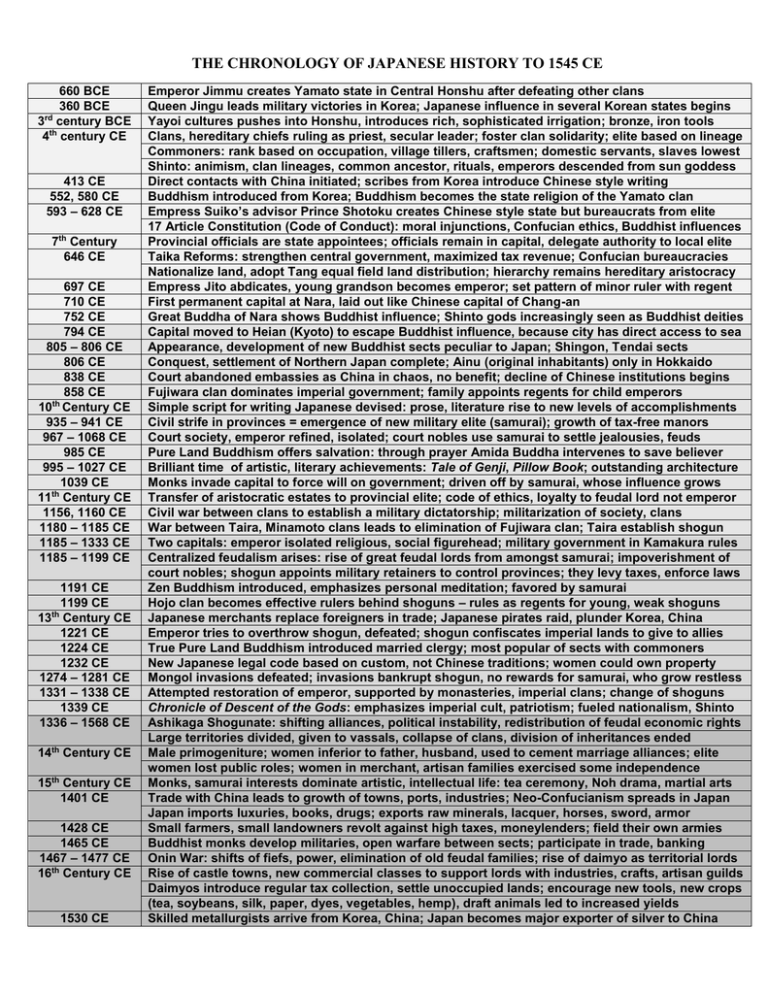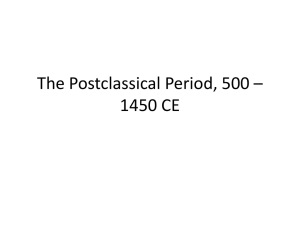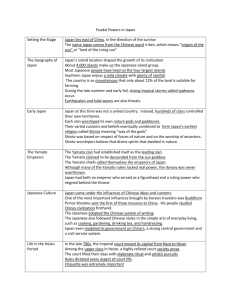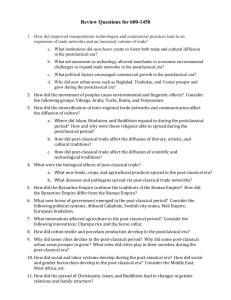THE CHRONOLOGY OF JAPANESE HISTORY TO 1545 CE
advertisement

THE CHRONOLOGY OF JAPANESE HISTORY TO 1545 CE 660 BCE 360 BCE 3rd century BCE 4th century CE 413 CE 552, 580 CE 593 – 628 CE 7th Century 646 CE 697 CE 710 CE 752 CE 794 CE 805 – 806 CE 806 CE 838 CE 858 CE 10th Century CE 935 – 941 CE 967 – 1068 CE 985 CE 995 – 1027 CE 1039 CE 11th Century CE 1156, 1160 CE 1180 – 1185 CE 1185 – 1333 CE 1185 – 1199 CE 1191 CE 1199 CE 13th Century CE 1221 CE 1224 CE 1232 CE 1274 – 1281 CE 1331 – 1338 CE 1339 CE 1336 – 1568 CE 14th Century CE 15th Century CE 1401 CE 1428 CE 1465 CE 1467 – 1477 CE 16th Century CE 1530 CE Emperor Jimmu creates Yamato state in Central Honshu after defeating other clans Queen Jingu leads military victories in Korea; Japanese influence in several Korean states begins Yayoi cultures pushes into Honshu, introduces rich, sophisticated irrigation; bronze, iron tools Clans, hereditary chiefs ruling as priest, secular leader; foster clan solidarity; elite based on lineage Commoners: rank based on occupation, village tillers, craftsmen; domestic servants, slaves lowest Shinto: animism, clan lineages, common ancestor, rituals, emperors descended from sun goddess Direct contacts with China initiated; scribes from Korea introduce Chinese style writing Buddhism introduced from Korea; Buddhism becomes the state religion of the Yamato clan Empress Suiko’s advisor Prince Shotoku creates Chinese style state but bureaucrats from elite 17 Article Constitution (Code of Conduct): moral injunctions, Confucian ethics, Buddhist influences Provincial officials are state appointees; officials remain in capital, delegate authority to local elite Taika Reforms: strengthen central government, maximized tax revenue; Confucian bureaucracies Nationalize land, adopt Tang equal field land distribution; hierarchy remains hereditary aristocracy Empress Jito abdicates, young grandson becomes emperor; set pattern of minor ruler with regent First permanent capital at Nara, laid out like Chinese capital of Chang-an Great Buddha of Nara shows Buddhist influence; Shinto gods increasingly seen as Buddhist deities Capital moved to Heian (Kyoto) to escape Buddhist influence, because city has direct access to sea Appearance, development of new Buddhist sects peculiar to Japan; Shingon, Tendai sects Conquest, settlement of Northern Japan complete; Ainu (original inhabitants) only in Hokkaido Court abandoned embassies as China in chaos, no benefit; decline of Chinese institutions begins Fujiwara clan dominates imperial government; family appoints regents for child emperors Simple script for writing Japanese devised: prose, literature rise to new levels of accomplishments Civil strife in provinces = emergence of new military elite (samurai); growth of tax-free manors Court society, emperor refined, isolated; court nobles use samurai to settle jealousies, feuds Pure Land Buddhism offers salvation: through prayer Amida Buddha intervenes to save believer Brilliant time of artistic, literary achievements: Tale of Genji, Pillow Book; outstanding architecture Monks invade capital to force will on government; driven off by samurai, whose influence grows Transfer of aristocratic estates to provincial elite; code of ethics, loyalty to feudal lord not emperor Civil war between clans to establish a military dictatorship; militarization of society, clans War between Taira, Minamoto clans leads to elimination of Fujiwara clan; Taira establish shogun Two capitals: emperor isolated religious, social figurehead; military government in Kamakura rules Centralized feudalism arises: rise of great feudal lords from amongst samurai; impoverishment of court nobles; shogun appoints military retainers to control provinces; they levy taxes, enforce laws Zen Buddhism introduced, emphasizes personal meditation; favored by samurai Hojo clan becomes effective rulers behind shoguns – rules as regents for young, weak shoguns Japanese merchants replace foreigners in trade; Japanese pirates raid, plunder Korea, China Emperor tries to overthrow shogun, defeated; shogun confiscates imperial lands to give to allies True Pure Land Buddhism introduced married clergy; most popular of sects with commoners New Japanese legal code based on custom, not Chinese traditions; women could own property Mongol invasions defeated; invasions bankrupt shogun, no rewards for samurai, who grow restless Attempted restoration of emperor, supported by monasteries, imperial clans; change of shoguns Chronicle of Descent of the Gods: emphasizes imperial cult, patriotism; fueled nationalism, Shinto Ashikaga Shogunate: shifting alliances, political instability, redistribution of feudal economic rights Large territories divided, given to vassals, collapse of clans, division of inheritances ended Male primogeniture; women inferior to father, husband, used to cement marriage alliances; elite women lost public roles; women in merchant, artisan families exercised some independence Monks, samurai interests dominate artistic, intellectual life: tea ceremony, Noh drama, martial arts Trade with China leads to growth of towns, ports, industries; Neo-Confucianism spreads in Japan Japan imports luxuries, books, drugs; exports raw minerals, lacquer, horses, sword, armor Small farmers, small landowners revolt against high taxes, moneylenders; field their own armies Buddhist monks develop militaries, open warfare between sects; participate in trade, banking Onin War: shifts of fiefs, power, elimination of old feudal families; rise of daimyo as territorial lords Rise of castle towns, new commercial classes to support lords with industries, crafts, artisan guilds Daimyos introduce regular tax collection, settle unoccupied lands; encourage new tools, new crops (tea, soybeans, silk, paper, dyes, vegetables, hemp), draft animals led to increased yields Skilled metallurgists arrive from Korea, China; Japan becomes major exporter of silver to China CHANGE OVER TIME BY CHRONOLOGICAL PERIOD: THEME Patterns, impacts of interaction amongst major societies: trade, exchanges, diplomacy, war, and international organizations ANCIENT/CLASSICAL PERIOD TO 794 POST-CLASSICAL TO 1185 CE POST-CLASSICAL TO 1530 CE THEME Changes in functions and structures of states, attitudes towards states, inc. identities, political parties (the political culture) and emergence of the nation-state ANCIENT/CLASSICAL PERIOD TO 794 POST-CLASSICAL TO 1185 CE POST-CLASSICAL TO 1530 CE CHANGE OVER TIME BY CHRONOLOGICAL PERIOD: THEME Impact of demography on people and the environment including migration, population growth and decline, disease, urbanization, environmental degradation, and agriculture ANCIENT/CLASSICAL PERIOD TO 794 POST-CLASSICAL TO 1185 CE POST-CLASSICAL TO 1530 CE THEME Impact of technology including agricultural techniques, weaponry, manufacturing, transportation and communications systems, and inventions ANCIENT/CLASSICAL PERIOD TO 794 POST-CLASSICAL TO 1185 CE POST-CLASSICAL TO 1530 CE CHANGE OVER TIME BY CHRONOLOGICAL PERIOD THEME Religious, intellectual, cultural, and artistic aspects, developments, interactions among and within societies ANCIENT/CLASSICAL PERIOD TO 794 POST-CLASSICAL TO 1185 CE POST-CLASSICAL TO 1530 CE THEME Systems of social, economic and gender structure including inequalities and work or labor systems ANCIENT/CLASSICAL PERIOD TO 794 POST-CLASSICAL TO 1185 CE POST-CLASSICAL TO 1530 CE CHANGE OVER TIME BY CHRONOLOGICAL PERIOD THEME The relationship of change and continuity between chronological periods What led to the changes or continuities between each periods? ANCIENT/CLASSICAL PERIOD TO 794 POST-CLASSICAL TO 1185 CE POST-CLASSICAL TO 1530 CE What would be a good thesis sentence to describe the change over time from the Neolithic Era through 1530 CE? Write one using at least three of the themes. At the center of Japanese history is its relationship with China. How has China’s relationship with China changed over time? A major theme, which has dominated Japanese history, is the nature and structure of its state and government. How has Japanese government changed over time and why? NAME: _________________________ PERIOD: _______ DATE: ________________ CHART: CHANGE OVER TIME OF JAPAN Summarize the time period – use SCRIPTED. Do at least three themes BEGINNING TIME PERIOD: Dates: Ancient/ Classical Period Key continuities and changes from previous periods INTERIM TIME PERIOD Dates: Early Post-Classical Period END TIME PERIOD Dates: Late Post-Classical Period Explain why change or continuity occurred




